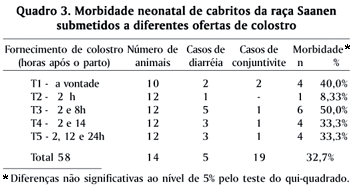The experiment was performed to determine the kid management that ensures the best passive immunity, and to evaluate the relationship between passive immunity, neonatal morbidity and performance. Blood samples were obtained from 58 Saanen kids before colostrum ingestion and 30h after. The kids were submitted to five treatments: (T1) kids were allowed to nurse the dam for 24 hours ingesting colostrum ad libitum; (T2) kids were bottle-fed with 200mL colostrum in the first hour of life; (T3) kids were bottle-fed with 400 mL colostrum, 200mL in the first hour and 200mL 8 hours after birth; (T4) kids were bottle-fed with 400mL colostrum, 200mL in the first hour and 200mL 14 hours after birth; (T5) kids were bottle-fed with 600mL of colostrum, 200mL in the first hour, 200ml 12 hours after birth, and 200mL at 24 hours of life. Serum levels of gamaglobulins were determined by electrophoresis. The occurrence of diseases was monitored from birth to 28 days. Daily weight gains were used to evaluate the performance until weaning. The lowest concentration of g-globulin was observed in Group 2 (1,57g/dL) and the highest in Group 3 (2,60g/dL). In spite of higher levels of passive immunity Group 3 showed more animals with scours, however no statistical differences were observed. The immune status at 30 hours postpartum was not associated with neonatal weight gain.
Immunity; immunoglobulins; colostrum; neonatal morbidity; performance; kids




